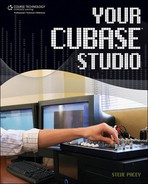7. Recording a Whole Band or Multiple Tracks at Once
Now you’ve learned how to record MIDI keyboards, MIDI drum kits, vocals, acoustic and electric guitars, and bass. With what you’ve learned so far, you can pretty much apply the same techniques to individually record almost any instrument on the planet! This is great news, but there is something magical about capturing the live performance of an entire band playing a well-rehearsed song. That magic can sometimes get lost when each instrument is recorded on its own. Now that you understand what each instrument requires for the best sound possible, it’s time to explore your options for capturing an entire band or a section of instruments (such as acoustic drums) all in one take, yet on separate tracks.
Recording a full band or multiple tracks at once is most likely going to require a lot more equipment, accessories, and physical space out of your Cubase studio. The hardware for recording multiple tracks at once can be expensive and usually involves a great deal of knowledge in order to fully understand. In today’s world, most professional music producers own DAW (digital audio workstation) studios with minimal equipment, and when it comes time for tracking, or for the final mix, they take their project to a professional, world-class studio. Doing this affords the producer the best sound, gives him ample tweaking time (from a home studio), provides amazing results, and costs a fraction of what the same record would have 10 years ago. My best advice for someone who owns a Cubase studio, but only occasionally records bands, would be to track the band at a professional studio. Whether or not the studio is equipped with Cubase isn’t important. As long as you are able to transfer the audio tracks to a digital file format (such as WAV or AIF), you will have plenty to work with when you take the project back to your own studio.
Figure 7.1. The layout of a large professional recording studio.

Even though the idea of using another studio (and probably paying an hourly or daily rate) sort of goes against the whole concept of owning a do-it-yourself Cubase studio, consider what you could be passing up by not using another studio:
Most studios come with an engineer who knows and understands the studio and all the equipment that comes with it. Some studios even provide assistant engineers and runners who may be able to help you out during the session.
Most professional studios provide expensive gear (such as a mixing console, microphones, mic pres, compressors, and baffles) that most home studios don’t have.
Most studios provide not only great-sounding recording rooms but also acoustically designed control rooms. The rooms sound better than most home studios, and they offer better isolation for multiple players.
When you’re paying someone else to worry about the technical issues with recording, you can concentrate more on actually making good music.
The studio atmosphere may actually inspire the band to perform better than they would normally.
If you’re lucky, you might even get free bagels, fruit, and coffee!
The idea of paying a studio may seem crazy to a lot of bands, but studio rates are pretty competitive in most cities. I’ve seen professional studios charge as little as $15 an hour (with a recording engineer)! A cost this low can be a lot more affordable for a band (especially if everyone’s chipping in) than buying a lot of expensive equipment to use at home with Cubase.
Although the option to record at a professional studio may make sense for some, it’s simply not a possibility or a necessity for all bands. For this reason, I will discuss the basics of how to record a band from a home Cubase studio. If you have already decided that taking your band to another studio is the right choice, you can skip to the end of this chapter for more information on working with another studio. If you’ve decided that your Cubase studio is the only studio you need, please read on.
When it comes to recording a live band or multiple tracks at once, each performer must be able to hear the mix the way that works best for them. This could mean that a separate monitor mix may be important for each member of the band. Also, as when recording individual instruments, each instrument must be captured in the best way possible. Communication can become very important and difficult when working with several performers at once. The most important piece of hardware to make your life easier on all of these levels is a good mixing console (also called a mixer or mixing board) (see Figure 7.2).
Figure 7.2. A professional-quality mixing console, the Midas Verona.

There are a lot of different mixing consoles on the market. You may already own one. It’s important you understand how a mixing console works so you know what you need for recording.
